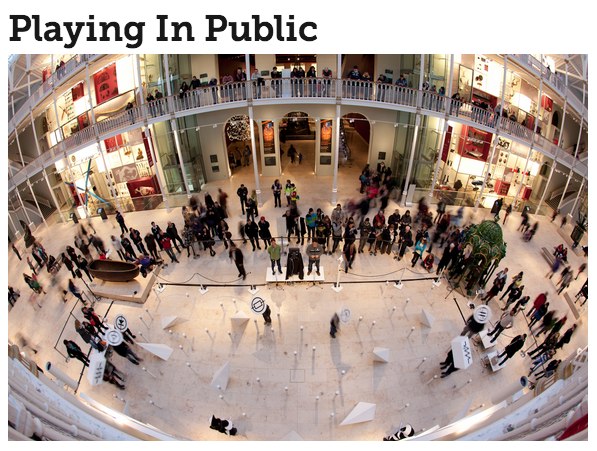
This is a small extract of a section of a chapter of the PhD I completed and passed this summber. I’m posting it in order to supplement a discussion I’m trying to have in 140 characters to very little avail. When I’ve thought long-form I struggle to shrink it! This will be different from the final version which (I hope) will be online in the new year. I have to submit some methodology clarifications before it can go up, but because of REF deadlines the uni have asked me to submit them in January. Blah Blah. Here:
Games as systems of control
However – before discussing games as a route to community, agency, abstraction, and the inbetween – a second caveat should be added. Although pervasive games have an ability to reunite personal choice with tangible consequence, to re-place the body in a metallic inbetween, this is not a solution. It is a way of seeing and a way of being which can amount to a friction-practice, but games are also systems of control (as well as a frame) – they are willingly entered into, but are also, fundamentally, experience engines. For this reason private interests will seek to use the form for control and profit (c.f. the Hollywood-style gaming blockbuster, or the practice of gamification* in advertising), and for this reason artists should also be in this space, making use of the affordances of games to re-reveal private interests.
Likewise the tyranny of ‘fun’ in games should be rejected. Games should not be defined by ‘fun’, but rather unwork. If ‘fun’ is the intended outcome then what you are demanding is a work – something with a product. The games theorist Jane McGonigal is perhaps the guiltiest of this approach. McGonigal situates pleasure (as opposed to unwork, or leisure) as a manner of empowerment – her view is that intrinsic[3] reward is what gaming offers (here gaming takes on a broad definition to include the pervasive, digital and traditional), and that the satisfied individual should be the ultimate end, because they are more productive, and can be applied to ‘fixing’ the world. In Reality is Broken, McGonigal suggests that in the context of global capitalism,
[…] everyone on the planet is being sold the same dream of extrinsic reward. […] but there is cause for hope. One group is opting out of this soul-deadening, planet-exhausting hedonic grind, and in larger and larger numbers: hard-core gamers. […] Good games are productive. The producing a higher quality of life… gamers aren’t escaping their real lives by playing games. They are actively making their real lives more rewarding. (2011, pp. 50-1)
Admittedly she is trying to argue against the rejection of games as ‘not serious’ (a problem Huizinga also dealt with) but the problem is that where Huizinga says that games are not the opposite of seriousness but both transcend and envelop it[4], McGonigal argues for the productivity of games. In the McGonigal view, games are systems that produce and players are throughput. Instead of a creation of a radical inbetween of unwork where one might discover a space and manner of being that the Spectacle cannot commodify, McGonigal proposes games as a form of equation. McGonigal’s terminology turns games design, which she calls the ‘optimisation of human experience’, into ‘an applied science’ where game designers ‘are becoming the most talented and powerful happiness engineers on the planet’ (2011, p. 38). This notion of ‘engineering happiness’ is deeply troubling. Game designers construct experience engines, spaces of possibility, McGonigal’s suggestion that these engines should be turned to any particular prescribed ‘product’ – for all the good intentions in the world – is at best wrongheaded, and at worst dangerous. McGonigal’s ‘happiness’ is contingent on a box-ticking model of personal fulfilment, and looks towards ‘harnessing’ the power of gamers as satisfied individuals; her aim is always an end. Instead, this thesis suggests, games are better situated as a route to a ‘middle’, to socio-political and personal practice. Or, in fact, to a Boalian notion of ‘happiness’ identified by Julie Salverson in her discussion of the experience of the witness:
Happiness, for Boal, is both a personal and a social task that is always difficult and involves making things better: more generous, more ethical, more just, more alive. […] I am interested in the importance, even the ethics, of a courageous, tough kind of happiness that is based […] in contact with others and oneself. (2006, p. 146)
McGonigal’s happiness is found in the end of the game, Boal’s is in the interplay. In the joined-up encounter with the subjective other or in the inbetween of ‘what is’ and ‘what if’ encountered when the magic circle traces the gaps in time, space, technology and social structures – that is where play becomes and can sustain true radicalism. Tassos Stevens of Coney delivered a talk as part of a series presented at the Wonderlab event in 2010, which brought together practitioners around the areas of playful structures and digital technology. In it he dealt directly with the McGonigal ‘productive’ gamer:
Jane McGonigal says reality is broken and let’s fix it with game, a whiff of formalin in the air. Her lens on the world is rather monocular, fundamentalist in the proper sense of the word. It rarely admits failure and dreams of a superhumanity. But I think I can do no better than make play with people, and forcing them into one game they don’t want to play is like trying to choreograph butterflies […] the best play doesn’t tell you how to act, play invites you to imagine what if and – if then – what do you want to do about it. It’s a principled belief that creates an action-space, where the agent of play is you. (2010)
Happiness is not a product, it is a practice, and, as Stevens suggests, radical play – that which truly opens an inbetween – doesn’t frame itself in terms of consequence, but invites the player to inhabit a space of possibility, a space of encounter, a place where the subject discovers their subjectivity and encounters the subjective other.
[3] As opposed to the ‘extrinsic’ rewards put forward by ‘globalisation’ (McGonigal, 2011, pp. 50-1).
[4] ‘[…] play’s the thing by itself. The play-concept as such is of a higher order than is seriousness. For seriousness seeks to exclude play, whereas play very well include seriousness’ (Huizinga, 1950, p. 45).


